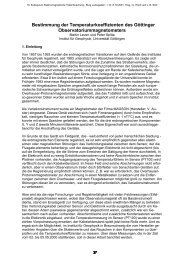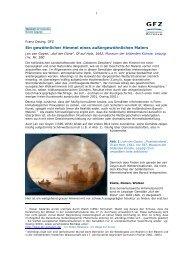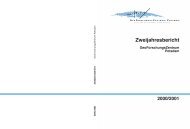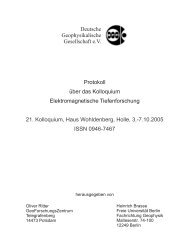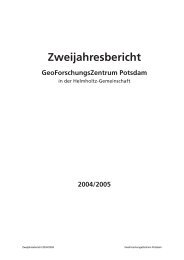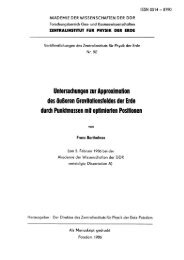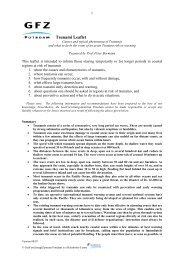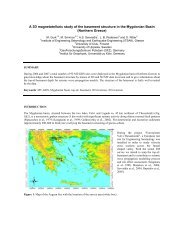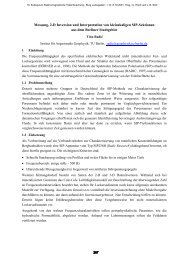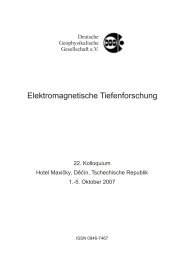Skies and Reality in Dutch Landscape - GFZ
Skies and Reality in Dutch Landscape - GFZ
Skies and Reality in Dutch Landscape - GFZ
You also want an ePaper? Increase the reach of your titles
YUMPU automatically turns print PDFs into web optimized ePapers that Google loves.
Franz Oss<strong>in</strong>g, <strong>GFZ</strong><br />
Realities <strong>in</strong> the <strong>Skies</strong><br />
A comment on John Walsh’s article “<strong>Skies</strong> <strong>and</strong> <strong>Reality</strong> <strong>in</strong> <strong>Dutch</strong> L<strong>and</strong>scape<br />
Pa<strong>in</strong>t<strong>in</strong>g” (1991)<br />
For more than a century there has been a discussion about the realism of <strong>Dutch</strong><br />
l<strong>and</strong>scape pa<strong>in</strong>t<strong>in</strong>g of the 17 th century. Clouds <strong>and</strong> other weather elements play a<br />
dom<strong>in</strong>ant role <strong>in</strong> these pa<strong>in</strong>t<strong>in</strong>gs. In addition, <strong>Dutch</strong> l<strong>and</strong>scapes are depicted with a<br />
geological preciseness, <strong>and</strong> even flora <strong>and</strong> fauna are shown <strong>in</strong> an unprecedented<br />
accuracy.<br />
The article by John Walsh “<strong>Skies</strong> <strong>and</strong> <strong>Reality</strong> <strong>in</strong> <strong>Dutch</strong> L<strong>and</strong>scape Pa<strong>in</strong>t<strong>in</strong>g” (Walsh 1991)<br />
is regarded as a st<strong>and</strong>ard as far as realism of clouds <strong>in</strong> <strong>Dutch</strong> l<strong>and</strong>scape pa<strong>in</strong>t<strong>in</strong>g is<br />
concerned. In fact, Walsh’s article is highly valuable as a contribution to the discussion<br />
on realism <strong>in</strong> <strong>Dutch</strong> pa<strong>in</strong>t<strong>in</strong>g because <strong>in</strong> contrast to Rostworowsky (1981) <strong>and</strong> other<br />
authors he <strong>in</strong>troduced the necessary scepticism <strong>in</strong>to the debate. <strong>Dutch</strong> l<strong>and</strong>scape<br />
pa<strong>in</strong>t<strong>in</strong>g was not an early form of l<strong>and</strong>scape photography. This, by the way, also means<br />
that pa<strong>in</strong>t<strong>in</strong>gs cannot be used as reliable climate proxy data. Walsh is right when he<br />
po<strong>in</strong>ts out that “pa<strong>in</strong>ters did not represent the <strong>Dutch</strong> climate <strong>in</strong> a way that was faithful to<br />
prevail<strong>in</strong>g conditions…” (p. 95) <strong>and</strong> that the 17 th century masters have a strong bias<br />
towards f<strong>in</strong>e or dramatic weather. In fact meteorologists <strong>and</strong> climatologists have<br />
dismissed the approach to determ<strong>in</strong>e climate <strong>and</strong> its changes from pa<strong>in</strong>t<strong>in</strong>gs because<br />
nature’s climate archives are more reliable. 1<br />
On the other h<strong>and</strong>, science can help to identify meteorology, geology, <strong>and</strong> climate <strong>in</strong><br />
pa<strong>in</strong>t<strong>in</strong>gs <strong>and</strong>, thus, give art historians an additional tool to <strong>in</strong>terprete the contents of<br />
the pictures. This is particularly true for <strong>Dutch</strong> l<strong>and</strong>scape pa<strong>in</strong>t<strong>in</strong>g of the 17 th century but<br />
automatically leads to the question: “How true to nature are the skies <strong>in</strong> <strong>Dutch</strong><br />
pa<strong>in</strong>t<strong>in</strong>g?” (Walsh, p. 94) Of course pa<strong>in</strong>t<strong>in</strong>g is not photography but <strong>Dutch</strong> cloud pa<strong>in</strong>t<strong>in</strong>g<br />
is more realistic than Walsh’s question <strong>in</strong>dicates.<br />
Weather <strong>in</strong> Central Europe<br />
If we talk about realism <strong>in</strong> depictions of atmospheric phenomena we always have to<br />
refer to the geographic region where “the weather” takes place. The Netherl<strong>and</strong>s are<br />
situated <strong>in</strong> the moderate latitudes of Europe. <strong>Dutch</strong> pa<strong>in</strong>ters were astute observers of<br />
nature, their depiction of flowers, <strong>in</strong>sects, trees <strong>and</strong> clouds were more realistic than ever<br />
before <strong>in</strong> art history. We should expect, therefore, that their cloud pa<strong>in</strong>t<strong>in</strong>g gives a<br />
reliable picture of the sky. In other words this means: if these sharp observers of nature<br />
did not reproduce <strong>in</strong> their pa<strong>in</strong>t<strong>in</strong>gs what they saw, there has to be a reason for that.<br />
Walsh correctly states that the k<strong>in</strong>ds of “atmospheric conditions <strong>in</strong> pa<strong>in</strong>t<strong>in</strong>gs<br />
nevertheless belong to surpris<strong>in</strong>gly few types. Artists generally showed the good or the<br />
bad, seldom the mediocre.” (Walsh, p.94). But from this he concludes that <strong>Dutch</strong> cloud<br />
pa<strong>in</strong>t<strong>in</strong>g was not at all typical for the weather <strong>in</strong> western Central Europe. “The most<br />
common k<strong>in</strong>ds of <strong>Dutch</strong> weather – a heavy deck of clouds, <strong>in</strong>termittent drizzle <strong>and</strong> heavy<br />
1 vgl. Oss<strong>in</strong>g (2012); modern paleo-climatology gets its <strong>in</strong>formation from ice cores, sediments,<br />
dendrochronology etc. These natural climate archives give reliable data sets that accurately describe past<br />
climate changes <strong>in</strong> a range of time-scales from millions of years to decades.
2<br />
ra<strong>in</strong>, <strong>and</strong> a veil of fog…”(Walsh, p. 96) is a description of weather <strong>in</strong> this part of Central<br />
Europe that was not even valid dur<strong>in</strong>g the Little Ice Age. It is true that there are no<br />
<strong>Dutch</strong> pa<strong>in</strong>t<strong>in</strong>gs that show a clear blue sky (Walsh, idib.) but the clouds that are pa<strong>in</strong>ted<br />
are meteorologically identifiable <strong>and</strong> <strong>in</strong> most cases rendered the atmosphere close to<br />
nature. This may serve as a def<strong>in</strong>ition for “realism”.<br />
The most common cloud type is stratocumulus (WMO, 1956, 1987a). 2 Actually there are<br />
a lot of pa<strong>in</strong>t<strong>in</strong>gs that show stratocumulus clouds, e.g. Jacob van Ruisdael’s smaller<br />
“Haarlempje” of the Pa<strong>in</strong>t<strong>in</strong>g Gallery <strong>in</strong> Berl<strong>in</strong> (c. 1670, Fig.1) which represents very<br />
normal weather <strong>in</strong> Holl<strong>and</strong>. Indeed a large number of clouds belong<strong>in</strong>g to different<br />
weather situations can be found <strong>in</strong> the galleries giv<strong>in</strong>g an overview of the types of<br />
weather prevail<strong>in</strong>g <strong>in</strong> Europe <strong>and</strong> dur<strong>in</strong>g the Little Ice Age (Oss<strong>in</strong>g 2001). We f<strong>in</strong>d w<strong>in</strong>ter<br />
scenes with a layer of stratus cloud break<strong>in</strong>g up: typical for w<strong>in</strong>ter morn<strong>in</strong>gs <strong>in</strong> a high<br />
pressure situation (van der Venne, Fig. 2), late summer days with cold air <strong>in</strong>vad<strong>in</strong>g<br />
Europe (Santvoort, Fig. 3), cumulonimbus clouds at the passage of a cold front <strong>in</strong> early<br />
spr<strong>in</strong>g (Asselijn, Muiderdijk, Fig. 4), <strong>and</strong> so on.<br />
Fig. 1: Ruisdael, Haarlempje Fig. 2: van der Venne, W<strong>in</strong>ter<br />
Fig. 3: Santvoort, L<strong>and</strong> <strong>and</strong> Farm Fig. 4: Asselijn, Muiderdijk<br />
All pa<strong>in</strong>t<strong>in</strong>gs by k<strong>in</strong>d permission of the Pa<strong>in</strong>t<strong>in</strong>g Gallery Berl<strong>in</strong> SMB, photos: Jörg P.<br />
Anders. (click on the pictures to enlarge)<br />
We can conclude that it is correct to say that <strong>Dutch</strong> l<strong>and</strong>scape pa<strong>in</strong>t<strong>in</strong>g of the 17 th<br />
century has a bias towards the f<strong>in</strong>e or dramatic weather. But this does not mean that<br />
the other European weather types are not found at all. It just means that certa<strong>in</strong> types<br />
of weather were pa<strong>in</strong>ted more frequently than others, as Walsh correctly writes. Of<br />
course this also means that one has to be very careful <strong>in</strong> any attempt to draw<br />
2 In George Siscoe’s photo (Walsh Fig.7, p. 102) it is hard to dist<strong>in</strong>guish the cloud type. However, it does not<br />
seem to be a stratocumulus as is written <strong>in</strong> the subtitle, but a cirrus cloud.
climatological conclusions from these pa<strong>in</strong>t<strong>in</strong>gs. But this has noth<strong>in</strong>g to do with the<br />
question if the depicted weather is “realistic” or not.<br />
3<br />
This seems to describe the situation as we see it today from the works of the “Golden<br />
Age” that have rema<strong>in</strong>ed <strong>in</strong> museums <strong>and</strong> collections. But a research project at the<br />
University of Amsterdam shows that between 1580 an 1800 a number of 8 to 10 million<br />
pa<strong>in</strong>t<strong>in</strong>gs were created (van der Woude 1991); alone <strong>in</strong> 1650 more than 70 000<br />
pa<strong>in</strong>t<strong>in</strong>gs were produced by the guild pa<strong>in</strong>ters, most of these l<strong>and</strong>scape pa<strong>in</strong>t<strong>in</strong>gs<br />
(Frijhoff/Spies 1999). Of this <strong>in</strong>credible amount, only 1 % has survived <strong>and</strong> can be found<br />
<strong>in</strong> the galleries today (van der Woude 1991, North 1992). Therefore, we could assume<br />
that the survivors do not represent the whole. It is true when Walsh po<strong>in</strong>ts to a limited<br />
number of atmospheric conditions, but recall<strong>in</strong>g the above-mentioned numbers our<br />
picture of the <strong>Dutch</strong> sky pa<strong>in</strong>t<strong>in</strong>g might as well be <strong>in</strong>complete.<br />
The Thermodynamics of Clouds<br />
Walsh’s argument, however, is not only restricted to the few atmospheric conditions that<br />
are depicted. Follow<strong>in</strong>g the space physicist George Siscoe he assumes that <strong>Dutch</strong> cloud<br />
pa<strong>in</strong>t<strong>in</strong>g “defies meteorology <strong>and</strong> thermodynamics” (Walsh, p. 96) which means that this<br />
cloud pa<strong>in</strong>t<strong>in</strong>g cannot be realistic at all. The argument is based on atmospheric<br />
thermodynamics <strong>and</strong> states correctly that a stable <strong>and</strong> an unstable atmosphere cannot<br />
exist together <strong>in</strong> close vic<strong>in</strong>ity. In fact, weather is noth<strong>in</strong>g else but the constant<br />
production of unstable conditions <strong>and</strong> the subsequent tendency of the atmosphere to<br />
rega<strong>in</strong> stable conditions. In general, low pressure zones have prevail<strong>in</strong>gly an unstable<br />
vertical stratification, highs are stable.<br />
Why then does <strong>Dutch</strong> l<strong>and</strong>scape pa<strong>in</strong>t<strong>in</strong>g defy the laws of atmospheric thermodynamics?<br />
Siscoe <strong>and</strong> Walsh state that stratiform <strong>and</strong> convective (cumulus) clouds are found<br />
together <strong>in</strong> the pa<strong>in</strong>t<strong>in</strong>gs which meteorologically is not possible.<br />
There are several assumptions <strong>in</strong> this statement that do not st<strong>and</strong> closer meteorological<br />
exam<strong>in</strong>ation. First, it is wrong to attribute stratiform clouds only to stable weather <strong>and</strong><br />
convective clouds only to unstable atmospheric conditions. Cumulus clouds can be found<br />
<strong>in</strong> high pressure zones <strong>and</strong> stratus clouds can be found <strong>in</strong> lows, the extrem case is a<br />
thunderstorm cloud (cumulonimbus) embedded <strong>in</strong> a heavy nimbostratus deck, still today<br />
a pilot’s nightmare. That is: stratiform <strong>and</strong> cumuliform types of clouds can co-exist, even<br />
<strong>in</strong> close vic<strong>in</strong>ity.<br />
Fig. 5: Salomon van Ruysdael, “River L<strong>and</strong>scape with a Ferry”,1630/35, by k<strong>in</strong>d<br />
permission of the Alte P<strong>in</strong>akothek Munich, Inv.Nr. 161. The clouds are cumuli that<br />
develop from stratus (Cu hum st-mutatus) (click to enlarge)<br />
Second, clouds can alter or mutate. One of Salomon van Ruysdael’s favourite sujets is a<br />
stratus layer aloft <strong>in</strong> early summer morn<strong>in</strong>gs that breaks up as the sun beg<strong>in</strong>s to heat<br />
the top of the cloud deck (Alte P<strong>in</strong>akothek, Fig. 5). This k<strong>in</strong>d of high pressure weather
can often be found over humid areas <strong>and</strong> leads to flat cumuli (cumulus humilis<br />
stratomutatus, WMO1986 3 ) that can persist for up to an hour.<br />
4<br />
This br<strong>in</strong>gs us to a third misunderst<strong>and</strong><strong>in</strong>g. With another pa<strong>in</strong>t<strong>in</strong>g of Salomon van<br />
Ruysdael (“River View of Nijmegen with the Valkhof “, F<strong>in</strong>e Arts Museums of San<br />
Francisco, 1648), Walsh <strong>and</strong> Siscoe underl<strong>in</strong>e their argument aga<strong>in</strong>st stratiform <strong>and</strong><br />
cumuliform clouds together <strong>in</strong> one picture: “Van Ruysdael shows flat layers, or stratus<br />
clouds, attached to puffy heaps, or cumulus clouds – an attachment that defies<br />
meteorology <strong>and</strong> thermodynamics.” (Walsh, p. 100) However, this is not true: what we<br />
see <strong>in</strong> this pa<strong>in</strong>t<strong>in</strong>g is the artist’s view of cumulus clouds <strong>and</strong> their cloud bases. 4 And<br />
there is no stratus cloud at all <strong>in</strong> the whole picture. Van Ruysdael pa<strong>in</strong>ted this picture <strong>in</strong><br />
1648, his earlier works had already shown his capacity as an accurate observer <strong>and</strong><br />
depictor of clouds (Fig. 5) <strong>and</strong> there is no reason why he should <strong>in</strong>corporate a high level<br />
cirrus with virga <strong>in</strong>to low level cumuli. There is another pa<strong>in</strong>t<strong>in</strong>g by S. van Ruysdael (“A<br />
View of Rhenen seen from the West”, 1648, National Gallery, London) <strong>in</strong> which we f<strong>in</strong>d<br />
aga<strong>in</strong> such “trail<strong>in</strong>g” l<strong>in</strong>es which is noth<strong>in</strong>g else but an artistic reproduction of cumulus<br />
cloud bases.<br />
Fig. 6: Cumulus clouds with<br />
their cloud bases, photo:<br />
F.Oss<strong>in</strong>g (click to enlarge)<br />
If such cumuli are observed at a flat angle their bases may appear as streaks (Fig. 6).<br />
This is cumulus congestus or mediocris (WMO, 1987a,b) <strong>and</strong> not “pseudocumulus codalis<br />
Ruisdalis” (Walsh p.106).<br />
F<strong>in</strong>ally, strong upward movement <strong>in</strong> cumulus or cumulonimbus clouds frequently causes<br />
the development of so-called accessory clouds that often stretch <strong>in</strong>to the horizontal, like<br />
altocumulus cumulogenitus, stratocumulus cumulogenitus. Even stretches of stratus of<br />
bad weather can develop from ra<strong>in</strong>-produc<strong>in</strong>g cumuli. It is not surpris<strong>in</strong>g that these<br />
accessory clouds can be found <strong>in</strong> <strong>Dutch</strong> cloud pa<strong>in</strong>t<strong>in</strong>gs when strong cumulus<br />
development is depicted (Fig.7a,b). And this does not defy the laws of thermodynamics.<br />
3 The designation of the clouds <strong>in</strong> this text follows the system of the International Cloud Atlas (WMO 1956ff)<br />
4 In the article, Walsh/Siscoe compare a special (high level) cirrus cloud with virga with the “trails” of Ruysdaels<br />
convective cloud (see photo at Walsh p. 100f). This is meteorologically a complete deviation which, however, is<br />
aimed to underl<strong>in</strong>e the argument: „For flat layers to grow cumulus heads <strong>in</strong>volves a graft<strong>in</strong>g of two different<br />
species, possible <strong>in</strong> the orchard of the artist’s imag<strong>in</strong>ation but not <strong>in</strong> nature.“ (Walsh, p.100) Nature’s orchard is<br />
richer than our imag<strong>in</strong>ation, but a cirrus <strong>in</strong> the cumulus niveau of the atmosphere is not a good comparison.
a) b)<br />
Fig. 7: Cumulus convection together with stratiform clouds, photo: F.Oss<strong>in</strong>g (click on<br />
the pictures to enlarge)<br />
Cumulus clouds <strong>and</strong> cloud bases<br />
5<br />
Cumulus clouds are ubiquitious <strong>in</strong> <strong>Dutch</strong> pa<strong>in</strong>t<strong>in</strong>gs. Walsh states that <strong>in</strong> particular the flat<br />
cumulus cloud bases are not depicted <strong>and</strong> that the clouds are often pa<strong>in</strong>ted distortedly<br />
for compositional reasons of the pa<strong>in</strong>t<strong>in</strong>g (Walsh p.100ff). It is right that a cumulus (or<br />
convective) cloud develops when a parcel of air rises. Due to cool<strong>in</strong>g dur<strong>in</strong>g the uplift<br />
condensation takes place at a certa<strong>in</strong> height, the so-called condensation level. But it is<br />
wrong to th<strong>in</strong>k that this always should create a sharp flat cloud base. Depend<strong>in</strong>g on the<br />
type <strong>and</strong> the age of an air mass <strong>in</strong> which cumuli form the condensation level can be a<br />
layer of condensation rather than a dist<strong>in</strong>ct level. 5 So not every cumulus cloud has a<br />
sharply def<strong>in</strong>ed cloud base <strong>and</strong> often a diffuse cloud base can be observed <strong>in</strong> nature (Fig.<br />
8a,b).<br />
a) b)<br />
Fig. 8: Cumuli with a sharp (a) <strong>and</strong> a diffuse (b) cloud base; photo: F.Oss<strong>in</strong>g (click on<br />
the pictures to enlarge)<br />
5 Geb (1981) proposed a thermodynamic classification of European air masses.<br />
Furthermore, even if such a sharp cloud base is<br />
present it can often hardly be detected if it is<br />
observered obliquely from the ground towards the<br />
cloud (Fig. 9).<br />
Fig. 9: Fair weather cumulus cloud base, observed<br />
obliquely, photo:F.Oss<strong>in</strong>g (click to enlarge)
6<br />
When comment<strong>in</strong>g on these cloud bases <strong>in</strong> de Kon<strong>in</strong>ck’s pa<strong>in</strong>t<strong>in</strong>gs (e.g. "L<strong>and</strong>scape <strong>in</strong><br />
Holl<strong>and</strong>" c.1665 , Hunterian Museum & Art Gallery collections, Glasgow) another<br />
meteorological misunderst<strong>and</strong><strong>in</strong>g leads to a mis<strong>in</strong>terpretation of the sky: de Konick<br />
“typically shows (.) a splendid undulat<strong>in</strong>g mass of clouds whose bases rise <strong>and</strong> s<strong>in</strong>k<br />
gracefully, if impossibly.” In fact de Kon<strong>in</strong>ck shows dist<strong>in</strong>ct cloud bases which are<br />
meteorologically correct (Fig. 10). If the view is at about 90° towards rows of cumulus<br />
clouds this is a common aspect of the sky. There is no “graceful but impossible ris<strong>in</strong>g <strong>and</strong><br />
s<strong>in</strong>k<strong>in</strong>g”, but there is a correct depiction of organized cumulus convection (Fig. 11).<br />
Fig. 10: Ph. Kon<strong>in</strong>ck, “An Extensive <strong>Dutch</strong> L<strong>and</strong>scape”, Berl<strong>in</strong> (click to enlarge)<br />
Fig. 11: Cumulus <strong>in</strong> rows (Cu med rad), photo: F.Oss<strong>in</strong>g (click to enlarge)<br />
Thunderstorms<br />
A thunderstorm <strong>in</strong> nature is a dom<strong>in</strong>at<strong>in</strong>g phenomenon <strong>in</strong> the sky, no matter at what<br />
distance it is seen. But thunderstorms appear <strong>in</strong> <strong>Dutch</strong> pa<strong>in</strong>t<strong>in</strong>gs usually at short<br />
distances. Walsh’s statement that the f<strong>in</strong>e or the dramatic weather prevails sky<br />
depictions of the masters of the 17 th century has to be re-exam<strong>in</strong>ed with respect to<br />
thunderstorm (cumulonimbus) clouds. The Ruisdael pa<strong>in</strong>t<strong>in</strong>g (“Panoramic view on the<br />
Amstel look<strong>in</strong>g towards Amsterdam”, Fitzwilliam Museum, Cambridge, UK), accord<strong>in</strong>g to<br />
Siscoe/Walsh shows “the only thunderstorm cloud <strong>in</strong> <strong>Dutch</strong> pa<strong>in</strong>t<strong>in</strong>g” (Walsh, p.103). A
closer view at the pa<strong>in</strong>t<strong>in</strong>g, however, shows that the cloud is a common cumulus<br />
congestus with midlevel (altocumulus) cloud above it, <strong>and</strong> not a thunderstorm.<br />
Secondly, thunderstorm clouds do exist <strong>in</strong> many <strong>Dutch</strong> pa<strong>in</strong>t<strong>in</strong>gs: J. van Goyen<br />
<strong>in</strong>troduces lightn<strong>in</strong>g <strong>in</strong>to <strong>Dutch</strong> l<strong>and</strong>scape pa<strong>in</strong>t<strong>in</strong>g (Giltaji/Kelch 1996, p. 164), A. Cuyp<br />
shows “The Maas at Dordrecht <strong>in</strong> a Storm” (about 1645-50, National Gallery London)<br />
with lightn<strong>in</strong>g of a thunderstorm, also J. van Ruisdael <strong>and</strong> H. Staets pa<strong>in</strong>ted flashes of<br />
lightn<strong>in</strong>g, <strong>and</strong> Dubbels (Collection Inder Rieden) shows a perfect thunderstorm <strong>in</strong> a<br />
warm air mass (Fig. 12).<br />
7<br />
Fig. 12: Hendrik Dubbels, “Shipp<strong>in</strong>g <strong>in</strong> a Calm”, canvas, 52 x 66,1 cm, signed: Dubbels,<br />
c. 1670, London, Collection Inder Rieden (click to enlarge)<br />
Conclusion<br />
The “Little Ice Age” project of the Pa<strong>in</strong>t<strong>in</strong>g Gallery Berl<strong>in</strong> <strong>and</strong> the <strong>GFZ</strong> German Research<br />
Centre for Geosciences (2001) could show that <strong>in</strong> most cases the meteorological,<br />
geological, <strong>and</strong> climatological elements <strong>in</strong> <strong>Dutch</strong> l<strong>and</strong>scape pa<strong>in</strong>t<strong>in</strong>g of the 17 th century<br />
are reproduced very close to nature. On the other h<strong>and</strong>, these pa<strong>in</strong>t<strong>in</strong>gs as pieces of arts<br />
are compositions follow<strong>in</strong>g the rules of art whereby the s<strong>in</strong>gle elements of these<br />
compositions are “realistic”. <strong>Dutch</strong> l<strong>and</strong>scape pa<strong>in</strong>t<strong>in</strong>gs show a contrieved reality, precise<br />
enough to appear as a real view <strong>in</strong>to l<strong>and</strong>scape. From this po<strong>in</strong>t of view the above<br />
mentioned “meteorological” objections of John Walsh <strong>and</strong> George Siscoe have to be<br />
rejected as they do not st<strong>and</strong> a closer exam<strong>in</strong>ation.<br />
There are, however, clouds that hardly or do not appear <strong>in</strong> <strong>Dutch</strong> pa<strong>in</strong>t<strong>in</strong>gs. The reasons<br />
for that are not based on meteorology. The explanation is at least two-fold, as the “Little<br />
Ice Age” project (here: Oss<strong>in</strong>g 2001) showed. The first reason is quite straight: cloud<br />
types with dom<strong>in</strong>ant features such as large horizontal cloud base l<strong>in</strong>es, wave clouds,<br />
long streaks of cirrus or patterns cover<strong>in</strong>g the whole sky would disturb the balanced<br />
composition of the pa<strong>in</strong>t<strong>in</strong>gs <strong>and</strong>, thus, do not or rarely appear. For the second reason<br />
we have to look <strong>in</strong>to the <strong>Dutch</strong> society of the 17 th century. In Holl<strong>and</strong> for first time <strong>in</strong><br />
history a free market for the arts developed, not depend<strong>in</strong>g on the court <strong>and</strong> the church<br />
but on fashion <strong>and</strong> on the taste of the masses of rich citizens, peasants <strong>and</strong> ship owners<br />
(North 2001).<br />
The “realism” as such is an only vaguely def<strong>in</strong>ed matter as far as the arts are concerned.<br />
However, there is no doubt that with <strong>Dutch</strong> pa<strong>in</strong>t<strong>in</strong>g of the 17 th century a revolution <strong>in</strong><br />
pa<strong>in</strong>t<strong>in</strong>g took place. The explanation of this revolution is not only matter of art history.<br />
<strong>Dutch</strong> pa<strong>in</strong>t<strong>in</strong>g started to reproduce its objects <strong>in</strong> a realistic way <strong>and</strong>, thus, shake off the<br />
traditional limitations that were given by religion or the court. At the same time this<br />
happened <strong>in</strong> science: modern sciences started with the liberation from religious
presett<strong>in</strong>gs <strong>and</strong> it was <strong>in</strong> the 17 th century when the profane, secular view on the world<br />
began to set the pace with Huygens, Kepler, Newton, Galileo, just to name a few.<br />
The <strong>in</strong>terpretation of the pa<strong>in</strong>t<strong>in</strong>gs, therefore, could f<strong>in</strong>d a fruitful enrichment <strong>in</strong> the<br />
cooperation of art historians, social sciences <strong>and</strong> natural sciences <strong>and</strong>, thus, break off<br />
the limits of a debate on realism whatsoever: “The current sharp dist<strong>in</strong>ction between<br />
the arts <strong>and</strong> science is a historical anomaly.” (Gedzelman 1991).<br />
Acknowledgements<br />
8<br />
The author wishes to thank Prof. Dr. Bernhard L<strong>in</strong>demann, Director of the Pa<strong>in</strong>t<strong>in</strong>g<br />
Gallery Berl<strong>in</strong> <strong>and</strong> Dr. Markus Dekiert of the Alte P<strong>in</strong>akothek, Bayerische<br />
Staatsgemäldesammlung for their helpful comments <strong>and</strong> their permissions to reproduce<br />
their pa<strong>in</strong>t<strong>in</strong>gs <strong>in</strong> this article. Prof. Jan Kelch encouraged me strongly to look at <strong>Dutch</strong><br />
pa<strong>in</strong>t<strong>in</strong>gs with a meteorologist’s view. Anthony Inder Rieden gave me access to the<br />
Dubbels pa<strong>in</strong>t<strong>in</strong>g (Fig. 12) <strong>and</strong> provided important <strong>in</strong>formation on the details of this<br />
pa<strong>in</strong>t<strong>in</strong>g for which I am deeply grateful. The meteorologists Prof. em. Dr. Günter<br />
Warnecke <strong>and</strong> Prof. em. Dr. Werner Wehry (both Free University of Berl<strong>in</strong>) analyzed <strong>and</strong><br />
fruitfully criticized my meteorological arguments <strong>and</strong> enriched the text with their vast<br />
experience. Mary Lav<strong>in</strong>-Zimmer translated my words <strong>in</strong>to her mother language, <strong>and</strong> I<br />
am happy to extend my thanks to all the persons named here.<br />
References:<br />
Freedberg, David/ de Vries, Jan (edit., 1991): “Art <strong>in</strong> History - History <strong>in</strong> Art. Studies <strong>in</strong><br />
Seventeenth-Century <strong>Dutch</strong> Culture", The Getty Center for the History of Art <strong>and</strong> the<br />
Humanities, Santa Monica, USA, 444 pp.<br />
Frijhoff, W./Spies, M. (1999): „1650. Bevochten eendracht“, with cooperation by Wiep<br />
van Bunge und Natascha Veldhorst, Nederl<strong>and</strong>se Cultuur <strong>in</strong> Europese Context, Sdu<br />
Uitgevers, Den Haag<br />
Geb, Manfred (1981): ”Klimatologische Grundlagen der Luftmassenbestimmung <strong>in</strong><br />
Mitteleuropa“, Beilage zur Berl<strong>in</strong>er Wetterkarte SO 7/81, Berl<strong>in</strong>, 32 pp.<br />
Gedzelman, Stanley D. (1991): „Atmospheric Optics <strong>in</strong> Art“, Appl. Optics, Vol. 30, No. 24,<br />
pp. 3514 - 3552, see his page on weather <strong>and</strong> arts<br />
Giltaij, Jeroen/Kelch, Jan (1996): “Herren der Meere – Meister der Kunst. Das<br />
holländische Seebild im 17. Jahrhundert”, exhibition catalogue, Berl<strong>in</strong>/Rotterdam, 472 S.<br />
North, Michael (2001): ”The Golden Age. Art <strong>and</strong> commerce <strong>in</strong> <strong>Dutch</strong> L<strong>and</strong>scape Pa<strong>in</strong>t<strong>in</strong>g of<br />
the 17 th century”, Böhlau Köln, 192 pp.<br />
Oss<strong>in</strong>g, Franz (2001): ”Der unvollständige Himmel. Zur Wolkendarstellung der holländischen<br />
Meister des 17.Jahrhunderts”, <strong>in</strong>: Pa<strong>in</strong>t<strong>in</strong>g Gallery Berl<strong>in</strong> SMB (2001), pp. 41-53; english<br />
version here: „The Incomplete Sky“<br />
Oss<strong>in</strong>g, Franz (2012): “Pa<strong>in</strong>t<strong>in</strong>gs as Climate Archives?”, translated from: <strong>GFZ</strong>-Journal<br />
1/2012, Potsdam 2012, S., digital: http://bib.gfzpotsdam.de/pub/wegezurkunst/pa<strong>in</strong>t<strong>in</strong>gs_as_climate_archives.pdf<br />
Pa<strong>in</strong>t<strong>in</strong>g Gallery Berl<strong>in</strong> SMB (edits., 2001): “Die Kle<strong>in</strong>e Eiszeit. Holländische<br />
L<strong>and</strong>schaftsmalerei im 17. Jahrhundert”, exhibition catalogue, Berl<strong>in</strong>, 92 pp. Electronically<br />
as PDF, selected chapters <strong>in</strong> English:<br />
www.gfz-potsdam.de/bib/pub/wegezurkunst/kle<strong>in</strong>e_eiszeit.htm<br />
Rostworowski, M. (1981): "L’Atlas des Nuages en Pe<strong>in</strong>ture Holl<strong>and</strong>aise", In: Ars Auro<br />
prior. Studia Ionnai Bialostocki sexagenario dicata. Warszawa: Panstwowe Wydawnictwo<br />
Naukow, 1981. S. 459-463.
Walsh, John: „<strong>Skies</strong> <strong>and</strong> <strong>Reality</strong> <strong>in</strong> <strong>Dutch</strong> L<strong>and</strong>scape“, <strong>in</strong>: David Freedberg/Jan de Vries<br />
(ed.), “Art <strong>in</strong> History – History <strong>in</strong> Art. Studies <strong>in</strong> seventeenth-century <strong>Dutch</strong> Culture,<br />
Santa Monica, CA, USA, 1991, pp. 94 – 117<br />
WMO (World Meteorological Organization, 1956): “International Cloud Atlas”, Vol. II,<br />
WMO, Geneva, 224 plates, two appendices<br />
WMO (World Meteorological Organization, 1987a): “International Cloud Atlas”, Vol. II,<br />
WMO, Geneva, 212 pp.<br />
9<br />
van der Woude, A. (1991): “The Volume <strong>and</strong> Value of Pa<strong>in</strong>t<strong>in</strong>gs <strong>in</strong> Holl<strong>and</strong> at the Time of<br />
the <strong>Dutch</strong> Republic”, <strong>in</strong> Freedberg, David und Jan de Vries [ed.] 1991, S. 285-32<br />
This text is from:<br />
http://www.gfz-potsdam.de/portal/gfz/Public+Relations/M50-Wege+zur+Kunst<br />
(click, then switch to English)



